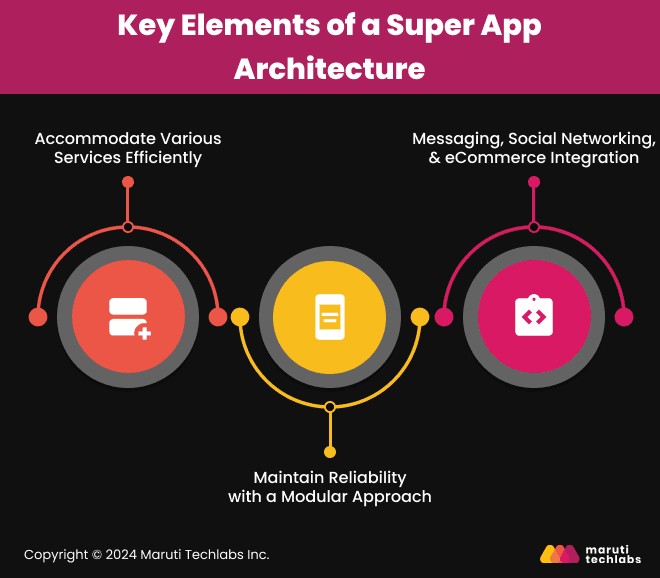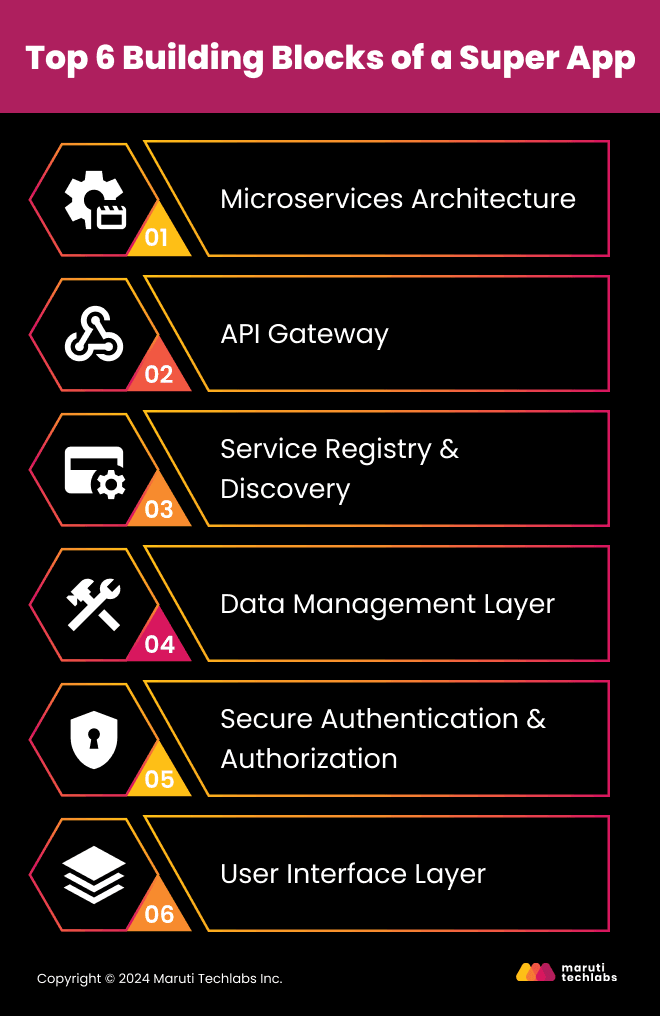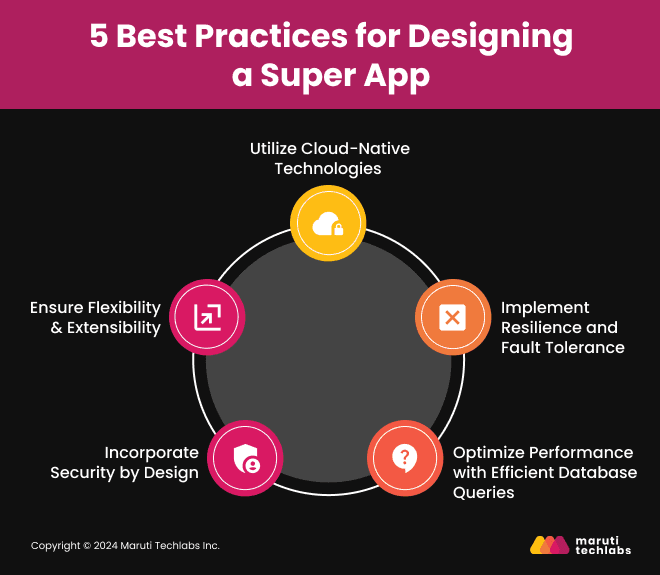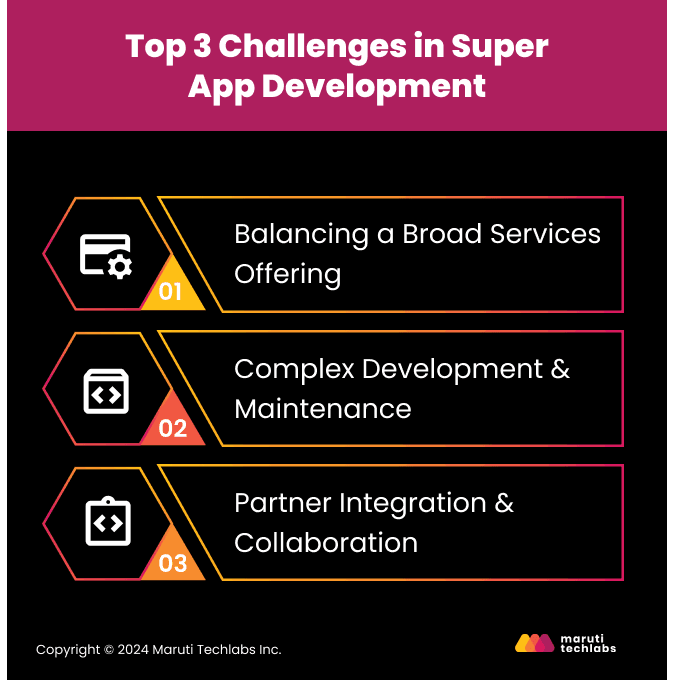

The Ultimate Guide to Building Your Own WeChat-like Super App






In 2025, the super app landscape is evolving rapidly. WeChat, once a messaging platform, has transformed into a comprehensive ecosystem encompassing social media, e-commerce, payments, and more.
According to Daxue Consulting, 6 out of 10 WeChat users engage with mini-programs, highlighting their integral role in user experience.
This blog delves into the strategies for building a super app akin to WeChat. We'll explore the technological requirements, roadmap to app development, and future innovations that you can include.
Whether you're a developer aiming to replicate WeChat's success or a business seeking to expand your digital ecosystem, this guide provides actionable insights to navigate the complexities of super app development.
A super app is a single mobile application that offers many different services in one place, like messaging, payments, shopping, food delivery, ride booking, and more. Instead of downloading multiple apps for each need, users can do everything inside one “super” platform.
Example: WeChat in China, where people chat, pay bills, order food, book rides, and shop—all within one app.
Here are 5 aspects that emphasize on the importance of building an app like WeChat.
Super apps integrate multiple services like messaging, payments, e-commerce, entertainment into one platform, creating convenience for users and deeper engagement for businesses.
They foster stronger brand loyalty, improve user experience, and allow companies to capture more value across diverse sectors while reducing operational complexity.
Super apps generate revenue through various models: transaction commissions, advertising, subscription fees, financial services (loans, payments, insurance), and partner integrations.
These diversified streams make super apps highly profitable, as they leverage high user engagement and transaction volume to create multiple monetization opportunities within a single platform.
By offering a wide range of integrated services, super apps create strong ecosystem effects. Users spend more time in-app, reducing the likelihood of switching to competitors.
This “lock-in” fosters loyalty, increases engagement, and makes it easier to introduce new services without losing the user base.
Super apps enable businesses to cross-sell related services effortlessly. For example, a payments service can recommend loans, e-commerce offers, or subscription packages.
Integrated data insights allow targeted, personalized offers, increasing customer lifetime value and revenue per user without requiring separate platforms.
Super apps simplify user experience by consolidating multiple services into a single interface. Users benefit from unified login, seamless payments, and consistent UI/UX.
Reduced friction drives higher adoption rates, deeper engagement, and increased transaction frequency, making the platform indispensable to daily digital life.
A super app is a unified platform that integrates a variety of services such as chat, payments, and shopping. These apps, which originated in Asia, have quickly acquired popularity due to their ease of use and comprehensive experience. Users no longer need to switch between several applications to complete various tasks because varied functionality has been consolidated into a single app.
This approach has led to an ecosystem where everything from communication to financial transactions occurs seamlessly in one place. WeChat, with its scalable and modular design, stands as a prime example of this concept, demonstrating efficiency, reliability, and a user-friendly experience.
To gain a better understanding, we’ll dive into the mechanics of how super apps integrate multiple services seamlessly.
Super apps streamline different services into a single platform, enhancing user convenience and engagement. Instead of switching between multiple apps to perform various tasks, users can chat, shop, pay bills, and book services all within the same app. For instance, WeChat offers mini-programs for banking, dining, and healthcare tasks, allowing users to access a wide range of services seamlessly.

Reliability is critical to the success of super applications. By adopting a modular architecture, each service operates as an independent unit, ensuring that an issue in one area doesn’t disrupt the entire platform.
Additionally, this design makes upgrades easier by enabling developers to improve or correct particular modules without affecting others. For example, Grab, a well-known mega app, uses this strategy to offer financial, food delivery, and ride-hailing services all at once while keeping platform operations running smoothly.
Super applications provide a platform for consumers to interact and transact through messaging, social networking, and e-commerce. For example, a user can shop, make social media posts, and then converse with friends through WeChat. Such integration adds more value to the product by enhancing its perpetuity in consumers’ usage and convenience.
Now that we understand how super apps operate let’s examine the components that bring this architecture to life.
Building a super app requires more than just adding multiple features. It’s about creating a robust architecture that ensures scalability, performance, and user satisfaction. The architecture of a super app like WeChat integrates several critical elements to deliver a seamless experience.

Here are the vital components driving its success:
Microservices architecture is a design approach that breaks down an application into smaller, independent services. Each service focuses on a specific business capability and communicates with others through well-defined APIs. This modular approach offers several benefits:
An API Gateway is the primary access point for all services. It handles routing, authentication, and requests between the app and its services, making interactions easier while maintaining communication security.
The service registry and discovery layer enables effective communication among various microservices within a super app. Finding the right person would be a nightmare without a reliable address system! Similarly, the service registry and discovery layer acts as that address system for microservices. This critical layer empowers microservices to:
Microservices can quickly locate and establish connections with each other, ensuring smooth interactions even during heavy traffic. This is similar to how an emergency response team in a city needs to locate each other quickly during a crisis.
Just like first responders must communicate rapidly to handle emergencies effectively, microservices need to connect quickly to maintain good performance during busy times. This ability to connect fast is essential for providing a reliable experience for users, especially when many people are using the app at once.
As super apps evolve by incorporating new features and functionalities, the service registry is critical in enabling the seamless integration of new microservices into the existing ecosystem. This process is akin to a city expanding with new districts; the service registry adjusts to accommodate the growing population of microservices.
The service registry lays the foundation for a super app’s continued growth and success. Its significance extends beyond mere service discovery, encompassing several key functionalities:
Furthermore, strong authorization and authentication procedures are necessary to safeguard private user information and guarantee safe service access within the super app architecture. Standards-based methods like JWT (JSON Web Tokens) and OAuth 2.0 can be implemented to protect user data while preserving smooth microservices-to-microservice interactions.
A super app must efficiently process data to avoid failures and inaccuracies. Optimized databases and caching systems ensure that users experience minimal delays, thereby improving the overall performance and reliability of the app.
Security is non-negotiable for super apps. Standards like OAuth 2.0 and JWT protect user data while ensuring secure access. These measures improve trust and confidence among users.
A super app’s UI must be simple and intuitive, accommodating to users on various devices. When using social programs on a smartphone, the engagement flows should be similar to those used on websites, ensuring consistency and usability.
Next, we’ll explore how WeChat has masterfully implemented these technical principles and reveal the strategies behind its widespread success.
WeChat started as a messaging app but grew into a super app that serves over a billion users daily. Its success comes from an innovative architecture designed to deliver multiple services seamlessly.
WeChat integrates mini-apps, e-commerce, payments, and messaging in one location. Users can order food, send communication, and make bill payments, among many other things, without even switching apps, which makes it an important place for millions of people.
WeChat allows smaller apps to run within its platform. For example, you can book a taxi or play a game without downloading separate apps. These mini-apps work independently but stay connected to WeChat’s main system. This flexibility lets the platform offer more features without overloading its platform.
Given the enormous number of users, WeChat’s architecture is optimized for scalability and quality. This modular, microservices-based design ensures the platform can handle huge traffic volumes while providing an outstanding user experience.
Knowledge of these components is important, but the key to their efficient application is the correct positioning of respective strategies.
Now, let’s look at some of the best practices for developing the structure of a super app.
Start with a minimal viable product (MVP) focusing on core features such as authentication, payments, messaging, and a primary service.
The goal is to validate the concept, gather user feedback, and build a foundation for incremental expansion without excessive upfront investment or complexity.
Expand functionality in phases, adding mini-apps, integrations, and specialized services over time. Prioritize features based on user demand, business impact, and feasibility.
Incremental rollouts reduce risk, allow for continuous testing, and help refine features before full-scale deployment, ensuring a smoother user adoption process.
Scaling involves integrating additional mini-apps and extending backend capabilities. Use microservices, cloud autoscaling, and container orchestration to handle growing user demand.
Optimize performance through load balancing, caching, database tuning, and CDN expansion to maintain speed, reliability, and a seamless user experience as the platform grows.
Implement analytics and monitoring tools to track performance, errors, and user behavior. Use insights to refine features, fix issues, and improve usability.
Regularly iterate the platform based on feedback, ensuring the super app evolves with changing user needs and market trends while maintaining stability.
A super app manages millions of users seamlessly by developing a robust framework that effortlessly handles high demand and ensures a satisfying user experience. Here are the best practices that make this possible:
Cloud-native technologies enable mega applications to expand as user demand grows. These platforms can automatically scale resources to accommodate more users during busy hours. For example, when millions of people log in during a holiday sale, dynamic scaling guarantees that the app runs smoothly and without delay.
Reliability is essential for gaining user trust. Super apps achieve this by designing redundancy and failover systems. For example, in payment services, downtime is simply not an option since it might interfere with transactions and negatively impact consumer satisfaction and trust.
Having several backup systems in place to ensure that transactions continue without interruption, even in the case of unforeseen failures, is known as redundancy. Furthermore, proactive problem detection and troubleshooting are made possible by using distributed tracing and monitoring tools, improving service availability and dependability even more.
Super apps handle a high volume of data in real-time. To keep everything running fast, developers use techniques like indexing and caching. For example, frequently used data—like user profiles or shopping recommendations—is cached to reduce database load and speed up responses.

Security should be a priority from the start. Encrypt sensitive data, ensure secure communication channels and use protocols like OAuth 2.0 for authentication. WeChat’s use of secure payment systems, for instance, builds trust by providing data privacy and preventing fraud.
A super app must grow with its users. The architecture should simplify adding new features or services without disrupting existing ones. For example, mini-apps within WeChat let businesses create tailored solutions for their customers, expanding functionality while keeping the app stable.
As previously said, these standards provide a solid basis; nonetheless, creating a great app is not without challenges. Addressing these obstacles is crucial to building a successful super app architecture like WeChat.
Creating a super app involves mastering the complexity of multiple systems while ensuring a seamless user experience.

Let’s break down the critical challenges developers must address to make it work.
Providing multiple services in one app can lead to conflicts in design priorities. For example, the needs of e-commerce may differ from those of messaging. Ensuring all features work harmoniously without compromising speed or usability is a constant challenge.
Super applications are services built from combined systems, making maintenance slightly more complex. For example, a change in one system may unintentionally affect another. To avoid disruption, the developers must guarantee that the test-as-a-service is implemented with strict safeguards.
Careful preparation is necessary when integrating third-party services, such as delivery or payment processors. Effective communication and strong APIs are essential for coordinating these partnerships to prevent interdependency and adequately isolate problems when they occur.
Although these problems might appear unresolved, they can be solved with the correct technical solutions. We’ll now look at how developers can successfully overcome these challenges.
Here are the technological and tools requirements necessary to build a superapp like WeChat.
Backend tech for super apps often includes Java, Node.js, Python, or Go for scalability. Frameworks like Spring Boot, Express.js, and Django help build robust APIs.
Microservices architectures are favored for flexibility, enabling independent development, deployment, and scaling of distinct app components.
Super apps rely on cloud infrastructure (AWS, Azure, Google Cloud) for scalability and global reach. Serverless computing reduces operational overhead, while container orchestration with Kubernetes ensures portability.
Edge computing minimizes latency for real-time services, enabling faster, localized responses critical for large-scale, globally distributed super app ecosystems.
Super apps support multiple front-end approaches. Native mobile apps offer rich performance, web apps provide accessibility, and mini-app frameworks (like WeChat mini-programs) allow fast development and integration.
A hybrid approach maximizes reach, user convenience, and flexibility while balancing performance and development cost.
Authentication tools like OAuth 2.0, OpenID Connect, Auth0, Firebase Auth, and Keycloak ensure secure user access. Multi-factor authentication (MFA) and biometric logins enhance security.
These tools also support single sign-on (SSO) across services, ensuring a seamless user experience within a super app.
Payment platforms such as Stripe, PayPal, Razorpay, and Alipay enable secure transactions. Super apps often integrate payment gateways, digital wallets, UPI, and QR-based payments.
Supporting multiple payment methods improves user convenience and broadens market reach while enabling monetization through commissions and transaction fees.
Messaging frameworks like Twilio, Sendbird, Firebase Cloud Messaging, and custom chat APIs power real-time communication.
Messaging features include chat, push notifications, in-app alerts, and bot-driven interactions, fostering engagement and enabling conversational commerce within the super app ecosystem.
Caching layers (Redis, Memcached, Varnish) enhance performance by storing frequently accessed data in memory. This reduces database load and latency, improving user experience.
Caching strategies are vital for high-traffic super apps to ensure responsiveness and scalability across services.
Content Delivery Networks like Cloudflare, Akamai, AWS CloudFront distribute content globally, reducing latency and improving performance.
CDNs are essential for delivering static assets, images, videos, and APIs in a super app to users across geographies with minimal delay.
Generative AI and ML enhance personalization, recommendations, and conversational features. AI models can analyze behavior to offer tailored content, dynamic offers, and predictive suggestions.
Conversational AI enables intelligent chatbots, voice assistants, and real-time language translation, making super apps more intuitive and engaging.
Building a framework like WeChat involves complex challenges that need advanced technical solutions. A well-designed system ensures reliable performance and makes it easier to add new features in the future. Let’s look at the primary strategies:
Fortunately, some technologies allow for such opportunities; for instance, we use React Native as the framework, which implies a faster overall development and dynamic approach to feature loading. This means that when an app is used, only necessary modules are used, not all others, which ensures quick response.
A well-structured architecture supports personalization by analyzing user behavior. For instance, AI-driven recommendations can suggest ride-hailing during peak hours or discounts based on user preferences, keeping engagement levels high.
Technical solutions form the backbone of a well-functioning super app, but engaging users requires more than just reliable infrastructure. Examine the strategies outlined below to boost user retention and enhance loyalty.
To continue the active usage of users in WeChat’s super app architecture, one has to understand their needs and provide them with the appropriate content.

Here’s how businesses can achieve this:
Syncing of different utilities such as messaging, shopping, and payment will make users depend on the app for their daily needs. For example, through the integration of mini-apps, WeChat offers businesses ways to offer some functions that will minimize the usage of other applications.
The app's ability to personalize services by understanding LoB (line of business) from user behavior makes it essential for everyday use. For instance, receiving personal discounts or choosing a restaurant with a physical location can be enjoyable and fulfilling options.
Working with vendors is a good way to increase app utility while spending less on development. For example, close cooperation with a ride-hailing service application or a food delivery vendor may increase the application’s popularity.
Here are the future trends that one can plan to include in their WeChat like super app.
Generative AI will transform super apps by enabling intelligent chatbots, AI assistants, and auto-generated content.
These capabilities enhance personalization, improve customer support, and automate creative tasks, making user interactions more dynamic, context-aware, and efficient, while increasing engagement and unlocking new monetization opportunities within the super app ecosystem.
Edge computing combined with 5G dramatically reduces latency, enabling real-time services like live streaming, AR experiences, and instant payments.
For super apps, this means faster, more responsive user interactions, especially in high-demand regions, making seamless global service delivery possible and enhancing competitive advantage.
Super apps will integrate voice interfaces, augmented reality (AR), and IoT devices to create immersive, intelligent experiences. Voice assistants enable hands-free interactions, AR improves product discovery, and IoT integrations provide contextual services.
Together, they transform super apps into comprehensive lifestyle ecosystems beyond simple transactional platforms.
Outside Asia, super app adoption faces regulatory, cultural, and competitive differences. Western markets often prefer specialized apps, requiring super apps to focus on interoperability and niche services.
Regulatory frameworks, data privacy laws, and user behavior shape adoption strategies, pushing innovation toward tailored, region-specific super app models.
Making an app architecture as good as WeChat requires technical expertise and strategic planning. Crucial components include implementing a scalable and modular architecture, enhancing modularity with frameworks, and ensuring flexibility for future growth.
By including these components in place, the app will be able to manage large user numbers and smoothly integrate a variety of services.
But to go beyond this kind of super app proficiency, it takes much more than an engineering approach. The app’s solutions must align with both future business goals and potential challenges. A successful super app should stay ahead of trends, meet user expectations, and support multiple services seamlessly within one platform.
At Maruti Techlabs, we develop robust super app architectures tailored to your business needs. Our expertise in software development, artificial intelligence, and product engineering ensures your app is scalable, reliable, and secure. Connect with us to transform your vision into a successful super app.
For businesses seeking top-tier mobile app development in Chicago, our team offers the experience and innovation needed to deliver results.
A super app is a multipurpose software that provides services to companies that sell anything from groceries to commodities.
User experience (UX) design is crucial because it directly impacts how users interact with the app. A well-designed UX ensures the app is intuitive, easy to navigate, and efficiently fulfills user needs. This helps retain users and encourages them to explore more features within the app, ultimately driving engagement and satisfaction.
Modular architecture enables regular upgrades and the addition of new features while maintaining user experience. As a result, the program continues to evolve and improve, providing consumers with access to the most recent features as well as a seamless updating procedure.
A super app can streamline your services into one platform, improve customer engagement, and create new revenue streams by integrating features like payments, e-commerce, and personalized recommendations.
Super applications are perfect for sectors where various services can be integrated to offer a smooth and practical user experience, such as retail, banking, healthcare, and transportation.


